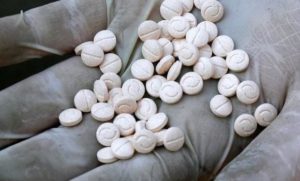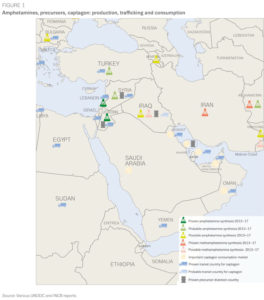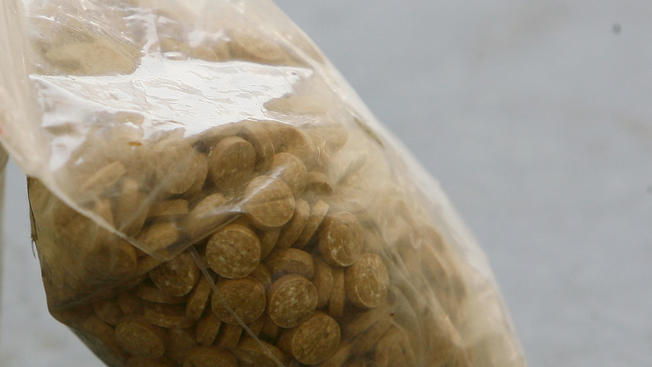If you’re in the US, you may not have heard of captagon—an understudied synthetic drug recreationally popular and widely traded in the Middle East. Unless, that is, you recall the racist and xenophobic rumblings that major media outlets stirred up about the drug back in 2015.
Even then, news reports failed to answer the question of what exactly the circular tablet was. Now, the European Monitoring Centre for Drugs and Drug Addiction (EMCDDA) has released an up-to-date report, “Captagon: Understanding today’s illicit market,” that surveys what is known and what is not about formerly white, but now usually beige, tablet pressed with two crescent moons.

Captagon was originally developed in Germany in the 1960s for use in Europe and the Middle East as a treatment for attention deficit disorder and narcolepsy. Captagon’s active ingredient, fenetylline, is a synthetic drug made up of amphetamine and theophylline, a mild stimulant similar to caffeine.
For the most part, Captagon was discontinued from therapeutic use when fenetylline was listed in 1986 under Schedule II of the United Nations Convention on Psychotropic Substances 1971.
Some countries, like the Netherlands, held large stocks of fenetylline even after the drug was scheduled. But as diverted pharmaceutical supplies began to dry up in the late 1990s, illicit production of the drug sold as “captagon” emerged to meet the growing Middle Eastern market. The chain of production is often split between labs producing amphetamine and others that stamp and cut the drug into captagon tablets. Because of the diffuse network of labs that work separately on each particular phase of production, the EMCDDA report speculates, the quality and contents of a captagon tablet are highly variable.
Limited forensic analysis of seized supplies reveals that fenetylline is often not even present in the tablets; rather, “captagon” includes varying proportions of amphetamine, theophylline, caffeine and other cutting agents. Simply, the EMCDDA report states that contemporary captagon can be described as “amphetamine in tablet form.”
Today, captagon is a popular recreational stimulant in the Middle East, especially the Arabian Peninsula, according to the survey, though the exact consumption rates are not quantifiable due to lack of data. Instead, estimates can be derived from seized quantities. Notably, 15 million captagon tablets were seized in Lebanon in 2015 alone. Above all, “It is notable that the quantities of amphetamine intercepted in the Arabian Peninsula since 2008 make up more than 50 percent of the global total,” the report says.

The EMCDDA also assesses the misinformation spread about the drug by major media outlets following a series of 2015 terrorist attacks. A drug unknown to most Americans, captagon was conflated with insurgent terrorist groups, like ISIL and Al-Quaeda, and dubbed “the terrorist drug,” “jihadi magic potion” or the “Daesh drug.”
Media attention mushroomed around the 2015 ISIS attacks in Paris, after an eye-witness was “quoted as reporting that the attackers seemed to be under the influence of drug.” The Washington Post and New York Magazine nudged along racist perceptions of ISIS members by suggesting that captagon use turned them into “superhuman soldiers” with “zombielike detachment”—even though the autopsy report “did not detect the use of ‘illicit drugs or alcohol’ before carrying out the attack,” according to the EMCDDA.
Although some evidence suggests that the perpetrator behind a terrorist 2015 attack in Tunis used captagon, there is little to no evidence, as confirmed by another study, to suggest that ISIS or other insurgent organizations systematically use it to enhance combat performance.
Even if they did, ISIS would not be the first; the United States liberally distributed speed to military combatants in the Vietnam War. The unsubstantiated panic around captagon-doped ISIS soldiers swelled not because of the pharmacological effects of the drug, but rather because of the perceived political threat it implied to the United States.
Now, however, the EMCDDA report makes two things clear: firstly, that “captagon, as it is now, is generally amphetamine with a captagon logo on it,” and second, “the evidence available does not indicate any particular association between captagon and terrorism.”
Photograph: Captagon image from Reuters via Business Insider and map image from AFP/Getty Images via NBC New York





Show Comments